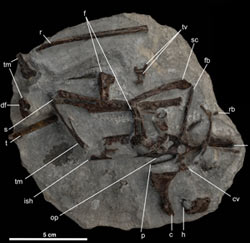Literature
Chinsamy, A. 2002. Bone microstructure of early birds; pp. 421-431 in L. M. Chiappe, and L. M. Witmer (eds.), Mesozoic Birds: Above the Heads of Dinosaurs, University of California Press, Berkeley, California.
Clarke, J., and M. Norell. 2002. The morphology and phylogenetic position of Apsaravis ukhaana from the Late Cretaceous of Mongolia. American Museum Novitates 3387:1-47.
Cooper, A., and R. Fortey. 1998. Evolutionary explosions and the phylogenetic fuse. Trends in Ecology and Evolution 13:151-156.
Cooper, A., and D. Penny. 1997. Mass survival of birds across the Cretaceous-Tertiary boundary: molecular evidence. Science 275:1109-1113.
Cracraft, J. 2001. Avian evolution, Gondwana biogeography and the Cretaceous-Tertiary mass extinction event. Proceedings of the Royal Society of London, B, 268:459-469.
Dyke, G., and M. van Tuinen. 2004. The evolutionary radiation of modern birds (Neornithes): reconciling molecules, morphology, and the fossil record. Zoological Journal of the Linnean Society 141:153-177.
Ericson, P. 1999. New material of Juncitarsus (Phoenicopteridae), with a guide for differentiating that genus from the Presbyornithidae (Aves: Anseriformes). Smithsonian Contributions in Paleobiology 89:245-251.
Ericson, P. 2000. Systematic revision, skeletal anatomy, and paleoecology of the New World early Tertiary Presbyornithidae (Aves: Anseriformes). PaleoBios 20:1-23.
Ericson, P. G. P., L. Christidis, A. Cooper, M. Irestedt, J. Jackson, U. S. Johansson, and J. A. Norman. 2002. A Gondwanan origin of passerine birds supported by DNA sequences of the endemic New Zealand wrens. Proceedings of the Royal Society of London, B, 269:235-241.
Fedducia, A. 1995. Explosive evolution in Tertiary birds and mammals. Science 267:637-638.
Feduccia, A. 2003. 'Big bang' for Tertiary birds? Trends in Ecology and Evolution 18:172-176.
Francillon-Viellot, H., et al.. 1990. pp. 471-530 in J. G. Carter (ed.), Skeletal Biomineralization: Patterns and Evolutionary Trends, Van Nostrand Reinhold, New York.
Groth, J., and G. Barrowclough. 1999. Basal divergences in birds and the phylogenetic utility of the nuclear RAG-1 gene. Molecular Phylogenetics and Evolution 21:974-983.
Harrison, G. L., P. A. McLenachan, M. J. Phillips, K. E. Slack, A. Cooper, and D. Penny. 2004. Four new avian mitochondrial genomes help get to basic evolutionary questions in the Late Cretaceous. Molecular Biology and Evolution 21:974-982.
Hedges, S., P. Parker, C. Sibley, and S. Kumar. 1996. Continental breakup and the ordinal diversification of birds and mammals. Nature 381:226-229.
Hope, S. 2002. The Mesozoic radiation of Neornithes; pp. 339-388 in L. M. Chiappe, and L. M. Witmer (eds.), Mesozoic Birds: Above the Heads of Dinosaurs, University of California Press, Berkeley, California.
Ketcham, R. A., and W. D. Carlson. 2001. Acquisistion, optimization, and interpretation of X-ray computed tomographic imagery: applications to the geosciences. Computers & Geosciences 27:381-400.
Kurochkin, E., G. Dyke, and A. A. Karhu. 2002. A new presbyornithid bird (Aves: Anseriformes) from the Late Cretaceous of southern Mongolia. American Museum Novitates 3386:1-11.
Livezey, B. 1997. The fossil Presbyornis and the interordinal relationships of waterfowl. Zoological Journal of the Linnean Society 121:361-428.
Marenssi, S., S. Salani, and S. Santillana. 2001. Geología de cabo Lamb, isla Vega, Antártida. Contribución Instituto Antártico Argentino 530:1-43.
Mayr, G., and J. Clarke. 2003. The deep divergences of neornithine birds: a phylogenetic analysis of morphological characters. Cladistics 19:527-553.
Noriega, J., and C. Tambussi. 1995. A Late Cretaceous Presbyornithidae (Aves: Anseriformes) from Vega Island, Antarctic Peninsula: paleobiogeographic implication. Ameghiniana 32:57-61.
Olson, S. 1999. The anseriform relationships of Anatalavis Olson and Parris (Anseranatidae), with a new species of the London Clay. Smithsonian Contributions in Paleobiology 89:231-243.
Olson, S., and A. Feduccia. 1980. Relationships and evolution of flamingos (Aves: Phoenicopteridae). Smithsonian Contributions in Zoology 316:1-73.
Padian, K., A. J. de Ricqlés, and J. R. Horner. 2001. Dinosaurian growth rates and bird origins. Nature 412:405-408.
Stidham, T. 1998. A lower jaw from a Cretaceous parrot. Nature 396:29-30.
van Tuinen, M., and B. Hedges. 2001. Calibration of avian molecular clocks. Molecular Biology and Evolution 18:206-213.
van Tuinen, M., T. Paton, O. Haddrath, and A. Baker. 2003. 'Big bang for Tertiary birds? A replay. Trends in Ecology and Evolution.




 ,
, 








